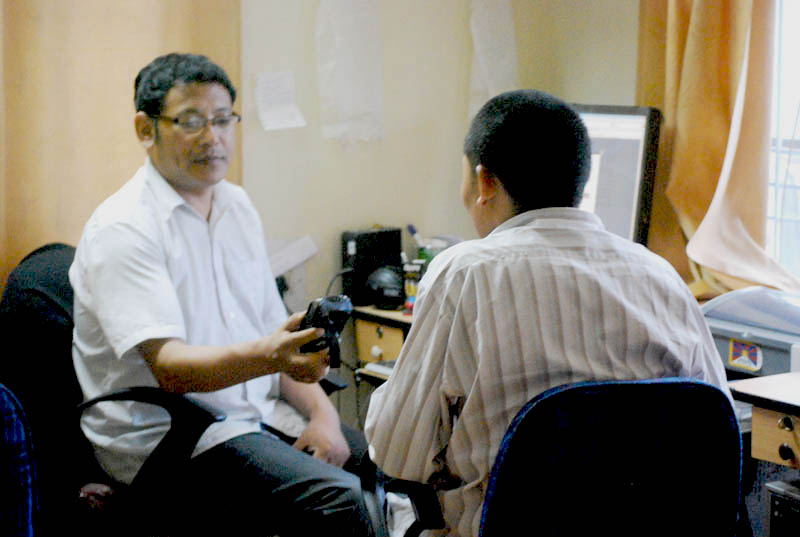 Dharamshala: Gelek was a monk from the eastern part of Tibet, and was pursuing a life of contemplation in Sera monastery near the Tibetan capital, Lhasa, before an irreversible brush with the Chinese state on March 2008. On March 10th, as anti-Chinese sentiment was brewing across the plateau in the run up to the Beijing Olympics, thirteen monks marched through Lhasa demanding human rights and freedom of expression and religion. All were arrested.
Dharamshala: Gelek was a monk from the eastern part of Tibet, and was pursuing a life of contemplation in Sera monastery near the Tibetan capital, Lhasa, before an irreversible brush with the Chinese state on March 2008. On March 10th, as anti-Chinese sentiment was brewing across the plateau in the run up to the Beijing Olympics, thirteen monks marched through Lhasa demanding human rights and freedom of expression and religion. All were arrested.
The situation escalated: the next day five hundred monks from Sera monastery, Gelek included, marched on Lhasa shouting for the release of the arrested monks alongside the aforementioned calls for greater freedom. Fifteen minutes into it they were met by almost a thousand Chinese paramilitary troops with tear gas, riot shields, electrical batons and guns. The monks were forcibly escorted back to Sera and surrounded in the monastery yard while negotiations were undertaken between the state and monastery officials (a proportion of the latter being state-appointed). As a result they were allowed back into their monastery, only with prison-like strictures imposed: none were allowed to make contact with the outside world, let alone leave.
On the 12th, between 3 and 5pm, around a hundred monks began shouting protest slogans. The act was repeated the next day, and on the 14th the monastery authorities warned that, if they continued, Chinese troops would storm the monastery and search their possessions for defamatory material - anything that might warrant arrest, pictures of His Holiness the Dalai Lama included. And so the monks stopped. But the troops would not disperse from outside the monastery. The monks remained in effective house arrest for a month, denied any outside contact. Many become sick, and were helpless to remedy themselves.
On the 10th of April, at 3am, paramilitary troops burst in with the common armoury of guns, tear gas, electrical batons - and in this case axes, to splinter the door of any monk who would deny them entry to their room. Gelek opened the door to one soldier and three policemen, who immediately fell to beating him with their electrical batons. Phones, wallets and rosaries were confiscated and 400 monks, Gelek included, were bundled into trucks and taken to Tsal Gongthang Detention Centre, 3km from Lhasa.
Monks such as Gelek from the so-called Autonomous Region were detained for eight months, with monks from elsewhere carted off to detention centres in their respective provinces. Alongside meagre food rations and a draconian regime of rules and regulations, Gelek was subjected to daily ‘patriotic' re-education: Chinese development tales of shiny new bridges and bountiful food provision were told, and their ‘crime' of protest was condemned as a dangerous act of separatism with the probable backing of foreign anti-Chinese forces - in much the same manner as His Holiness the Dalai Lama is condemned as a lackey of Western imperialist powers. The monks were interrogated one by one, and Gelek was firm that he protested neither for His Holiness the Dalai Lama nor foreign intervention but simply to bemoan the lack of religious freedom and the Chinese state limitation of monk numbers in monasteries. The interrogator, however, was a sympathetic Tibetan who advised him to exercise caution in everything he said.
As time went on many monks became sick, and were only allocated medical help if they successfully coughed up blood. The ‘beds' provided - raised plinths of concrete on the cell floor - gave rise to agonising swelling conditions, not least for Gelek. After the eight months they were transferred to detention centres in their own respective districts - Chamdo county, in Gelek's case. Much the same rigmarole continued for Gelek for the next month and eleven days, after which he was finally released on the 12th January 2009. Gelek returned to his village, but life could not return to how it was. He was forbidden for two years to travel beyond his village without official permission, he was kept under regular surveillance and, most galling of all, he could never again practice as a monk.
Increasingly frustrated at the half-life he was forced to lead, he made contact, through a series of discreet connections, with an outfit dedicated to smuggling Tibetans across the Himalayan divide. He paid the mandatory 16,000 Chinese Yen (2,362 US Dollars) and his escape began on the 27th of May 2010, travelling in a taxi for three days and a night and walking the rest of the way. Thanks to an expert guide with a knowledge of hidden routes, he evaded capture from the Chinese border guards and arrived in Nepal on the 4th of June. After a stint of rehabilitation in the reception centre in Kathmandu, he was conveyed to Delhi on the 18th of June, arriving two days later in McLeod Ganj, Dharamsala. Since then Gelek has been staying in the reception centre for recent arrivals on Jogiwara road, and he looks forward to his meeting with the Tibetan leader, whose presence drives so many Tibetans to brave the escape over the high Himalayan passes. Reduced circumstances may still plague Gelek in McLeod Ganj, and his future remains uncertain - but for now he can enjoy an environment of relative freedom among his own kind, in a society where his rights are respected and his ancient culture is permitted to flourish.


![Tibet has a rich history as a sovereign nation until the 1950s when it was invaded by China. [Photo: File]](/images/stories/Pics-2024/March/Tibet-Nation-1940s.jpg#joomlaImage://local-images/stories/Pics-2024/March/Tibet-Nation-1940s.jpg?width=1489&height=878)















